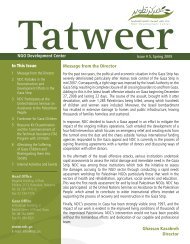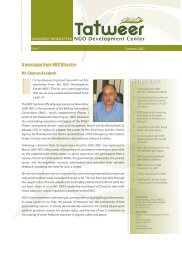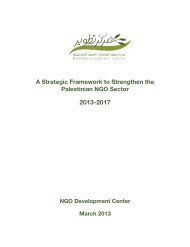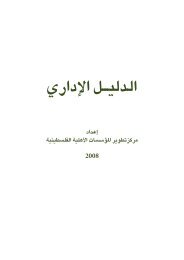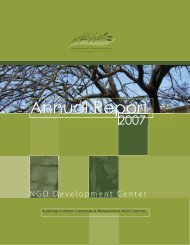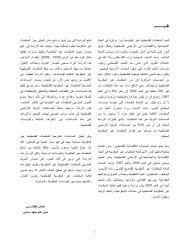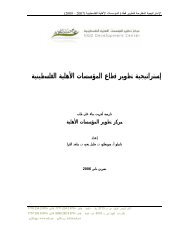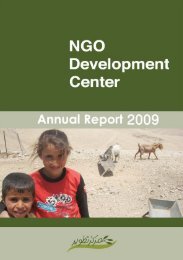Tracking External Donor Funding.pdf - NDC
Tracking External Donor Funding.pdf - NDC
Tracking External Donor Funding.pdf - NDC
You also want an ePaper? Increase the reach of your titles
YUMPU automatically turns print PDFs into web optimized ePapers that Google loves.
Figure 39: Location of Implementation of <strong>External</strong>ly Funded Projects<br />
Carried Out in Partnership with PNGOs by Region (1999-2008)<br />
70%<br />
60%<br />
50%<br />
40%<br />
30%<br />
20%<br />
10%<br />
0%<br />
1999 2000 2001 2002 2003 2004 2005 2006 2007 2008<br />
N. WB C. WB S. WB GS<br />
Source: MAS, 2009 – <strong>Donor</strong> Survey<br />
3.8.6 Overview: Geographic Distribution of<br />
PNGOs and <strong>External</strong> Aid<br />
The Figure 40 below works to summarize the story of<br />
external aid and PNGO activity in terms of geography.<br />
The first, checkered, bar represents the regional<br />
distribution of the Palestinian population as a whole in<br />
2006. The second striped bar represents the location of<br />
donor HQs in 2008. As mentioned above, there is an<br />
overwhelming presence in the Central West Bank as<br />
opposed to the rest of the oPT. The black bar shows how<br />
PNGOs are distributed throughout the oPT, with<br />
thelowest percentage actually being in the Central West<br />
Bank. The grey bar, representing the location of<br />
international aid agency partner PNGO HQs, shows that<br />
although there are a smaller number of PNGOs in the<br />
Central West Bank, they enjoy much greater access to<br />
international funds other regions. Finally, the white bar<br />
represents the location of internationally funded projects<br />
implemented by partner PNGOs. Though much more<br />
evenly distributed throughout the oPT than partnership<br />
HQs, there is still a higher percentage of funds targeting<br />
the Central West Bank than any other region – despite<br />
the fact that in many ways, it is the least in need of<br />
assistance.<br />
Figure 40: Geographic Breakdown of International Aid to PNGOs<br />
90%<br />
80%<br />
70%<br />
60%<br />
50%<br />
40%<br />
30%<br />
20%<br />
10%<br />
0%<br />
N WB C WB S WB GS<br />
Palestinian Population<br />
<strong>Donor</strong> Location<br />
All NGO Location<br />
<strong>Donor</strong> Partner Location<br />
<strong>Donor</strong> Project Implementation<br />
Source: <strong>Donor</strong> HQ source: Source: PASSIA Organizations Directory, 2009. 130 listed<br />
organizations.<br />
NGO HQ Source: MAS, 2007. – figures are from 2006. <strong>Donor</strong> implementation and<br />
Partnership Source: MAS, 2009 – <strong>Donor</strong> Survey.<br />
Palestinian Population Source: PCBS, 2007 Census.<br />
54


